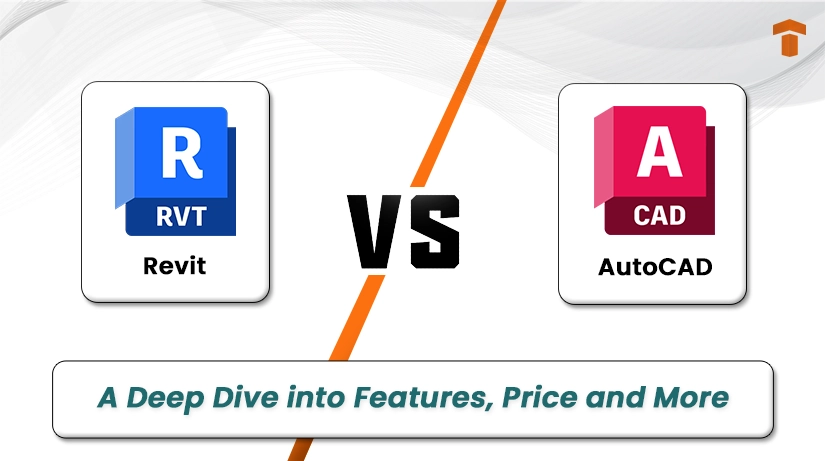Revit Vs AutoCAD: A Deep Dive into Features and More
Aug 16, 2024
Category: Software & Tools
Admin

AutoCAD and Revit are spearheading the revolutionary change in the AEC industry by streamlining the work for engineers and architects. Lots of people think that these software are competitors and make this battle of Revit vs AutoCAD, however, they complement each other as Autodesk has developed them.
Architects and engineers leverage these software to create construction drawings in 2D and 3D. In this blog, let’s delve into the key differences between Revit and AutoCAD and also shed light on various aspects of these software.
AutoCAD Introduction
Released by Autodesk in 1982, AutoCAD is a 2D drafting software. Architects and engineers have leveraged this software for decades for the creation of clear 2D lines that showcase the dimensions as well as features of the faces of 3D structures.
AutoCAD enables AEC stakeholders to conveniently create and edit existing or new designs for floor plans, buildings, and MEP systems. This software also provides the convenience of saving a design for future use. Newly added 3D modeling and designing features allow designers to create 3D designs with a whole new perspective.
Revit Introduction
Revit is a popular Building Information Modeling (BIM) software that was launched by Revit Technology in 2000. However, Autodesk purchased it in 2002. This 3D CAD modeling software empowers the users to create 3D parts and structures as per the specific dimensions.
It is mostly used in MEP (Mechanical, Electrical, and Plumbing) designs for new places, as this software best suits BIM.
Major Differences Between Revit and AutoCAD
Now that you have a basic understanding of these two software, let’s do a quick Revit vs AutoCAD to learn the differences between them.
2D vs 3D
AutoCAD allows the creation of designs, just like drawing on a paper sheet. These lines are the representation of real 3D elements, which is called Computer Aided Design (CAD). The drawn lines in AutoCAD do not have any information or data related to them.
However, in Revit, you can use 3D components to build 3D models. Just imagine these 3D components as the upgraded versions of the dynamic blocks in AutoCAD. A Revit model is almost a representation of a real building.
Separate Designs vs One Single Model
AutoCAD is the leading software that assists in drawing every element of a building separately. In this software, a designer can use one part of the workspace to create the plans for a building.
Other parts of the workspace help in the creation of sections, details, elevations, and schedules.
On the other hand, Revit provides the ease of working through a single model. One has to begin by creating the building design and then the software creates building plans as well as elevations. Revit is also smart enough to create sections automatically, leveraging the building plans.
For example, if a change is made by the user in one view, this software updates 3D elevation and section views automatically.
Multiple Updations Vs Single Update
The major difference that gets underlined while doing a Revit vs AutoCAD comparison is the update or change process in these software.
AutoCAD may not match the smart working standards of 2024, as one has to update the wall and window dimensions in every floor plan, section, elevation, details, and schedule. Moreover, updating all leaders, references, and tags is also crucial. It is a time-consuming process and is not suitable for a large-scale project.
On the flip side, while using Revit, all you have to do is make changes in the properties of the wall and window once. After that, Revit automatically updates all schedules, views, and clouds. Furthermore, you can complete this update without missing a drawing.
Revit’s System Requirements
Here, let’s do a Revit vs AutoCAD for system requirements:
Revit requires a higher computing power in comparison to AutoCAD. The system requirements are listed below:
Operating System: Windows 10, 64-bit (Windows Only).
CPU: To run Revit efficiently, a multi-core processor and a high-speed CPU are recommended.
Minimum RAM: 8 GB
Video Display: Maximum: 3840 x 2160 (4K) and Minimum: 1280 x 1024.
Minimum Computer Storage: 30 GB
Internet Connection: Required for downloading components and license registration.
AutoCAD’s System Requirements
Here’s the next part in Revit vs AutoCAD, the system requirements for AutoCAD:
Operating System: macOS Catalina v10.15 or newer and Windows 7 SP1 or newer (64-bit) only.
CPU: Recommended is 3.0+ and Minimum 2.5 GHz.
Minimum RAM: 8 GB
Video Display: Maximum: 3840 x 2160 (4K) and Minimum: 1920 x 1080.
Internet Connection: Required for accessing the AutoCAD web app and for initial licensing registration.
Conclusion
In this blog, we explored Revit vs AutoCAD at length and discovered that both software are essential for AEC (Architects, Engineers and Construction) experts.
Revit and AutoCAD complement each other, although Revit has an edge over AutoCAD as it enables building information modeling. Leverage these software to get the most out of your work as an AEC expert.
FAQs
Q1. What are the alternatives to Revit and AutoCAD?
Ans. Alternatives to Revit and AutoCAD are DataCAD, SketchUp, TinkerCAD, and FreeCAD. These programs can be used to create 2D drawings and 3D models, but they are not as advanced as Revit or AutoCAD.
Q2. Which software is better, Revit vs AutoCAD?
Ans. Both of these software are owned by the same brand, AutoDesk, and complement each other. But Revit has an upper hand over AutoCAD as it provides 3D modeling tools and makes it easy to create large models.
Q3. Which one is more difficult to learn in Revit vs AutoCAD?
Ans. New users can find it tough to learn both Revit and AutoCAD. However, Revit can be more difficult to grasp due to its advanced features. One needs to receive extensive training and practice to make the most of Revit.








